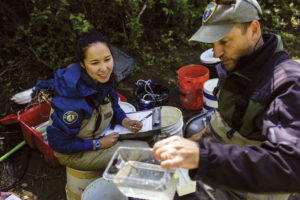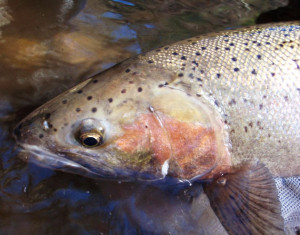Things are looking up for the steelhead trout of Alameda Creek. A revised plan to replace the Calaveras Dam includes several features that will benefit the federally threatened fish, in a departure from earlier proposals. The San Francisco Public Utilities Commission (SFPUC) approved the project on January 27, 2011, ending years of discussion with conservation groups and federal agencies.
“It’s a major victory for the watershed, and it’s a major victory for steelhead restoration in the Bay Area,” said Jeff Miller, director of the Alameda Creek Alliance. His organization has lobbied the SFPUC to consider Calaveras Dam’s effects on steelhead since 1998.
Tim Ramirez, manager of SFPUC’s watershed and natural resource division, also praised the approval. “It is a huge accomplishment for the organization,” he said, “and it’s a big accomplishment for the resource agencies and the NGOs.”
Situated in the upper Alameda Creek watershed, Calaveras Dam obstructs passage for migratory steelhead. Its completion in 1925 trapped ocean-bound fish above Calaveras Reservoir, and blocked access to the headwaters of Alameda Creek, which are considered the best spawning habitat in the watershed. An additional diversion dam that redirects water to the reservoir disrupts natural stream flows, creating further difficulties for steelhead.
An opportunity to mitigate the dam’s impact on steelhead appeared in 2001, when concerns surfaced about the structure’s seismic resistance. The state Division of Safety of Dams, part of the Department of Water Resources, restricted the reservoir to 30 percent storage capacity, and research into building a replacement dam began.
Initial proposals did not look promising for the fish, said Miller. A 2009 draft EIR for the replacement project forecast insufficient flow releases and operational changes to restore a sustainable run of steelhead below the dam.
Both citizen groups and federal agencies called on the SFPUC to better address the plight of steelhead. The Alameda Creek Alliance led an advocacy effort joined by over 70 local organizations. “It would not have happened without constant pressure and advocacy from our group and other groups,” said Miller.
Yet he specially credits the government for improving the project’s steelhead outlook. “The state and federal regulatory agencies really stood their ground for the natural resources,” he said. “They required really tough permit conditions.”
Specifically, the National Marine Fisheries Service enforced the Endangered Species Act by requiring increased stream flows and improved habitat conditions.
Those will take the form of year-round water releases from Calaveras Reservoir, which will improve water quality and rearing conditions in Alameda Creek. The SFPUC will also limit flow diversions during winter and spring — steelhead spawning season. Finally, the diversion dam will receive a fish ladder to enable migratory passage, and a new screen will line the diversion tunnel so that fish don’t get pulled in.
Miller declined to estimate the number of steelhead trout that will benefit from these modifications. “It depends on ocean conditions and habitat quality,” he said. “But we are quantifying the miles of habitat that’ll be made suitable for spawning.”
That could amount to 20 miles, in conjunction with downstream barrier removal projects. Several remaining impediments to steelhead entering the watershed, such as the BART weir in Fremont and some floating rubber dams, will receive fish ladders over the next couple of years. “We’ve been pushing them for the past 13 years to get that modified so fish can get past it,” said Miller, referring to the Alameda Flood Control District, which owns the BART weir. That fish ladder will go in next year.
Construction on the SFPUC dam replacement project will begin later this year, and continue through 2014. The SFPUC’s Ramirez said the steelhead features should be in place by 2015.
“From our standpoint, our work is just beginning,” he said. “Building the dam and getting it done on schedule is an immense accomplishment still ahead of us.”
Still, Ramirez acknowledged the project approval’s significance. “It’s been a long road, and it took a lot of work by a lot of different people,” he said. “There’s more in front of us, but it’s certainly a moment to stand back. Everybody should feel good.”

.jpg)


-300x210.jpg)
